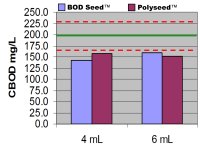cBOD
Nitrogenous Oxygen Demand (NOD)
cBOD v. BOD - If you have Nitrogenous Oxygen Demand (NOD) you should consider analyzing cBOD vs. BOD
Nitrogenous oxygen demand is the amount of oxygen used during the breakdown or chemical breakdown and conversion of organic nitrogen and inorganic nitrogen forms. We are typically concerned with the inorganic forms, and specifically, ammonia. This means that if the wastewater contains ammonia (and some do, particularly lagoons) and the nitrifying bacteria are present, then oxygen can be used in the conversion of nitrogen forms. This oxygen used up is measured as BOD, leading to BOD results biased high. The key equations are as follows:
Reduced Nitrogen (Ammonia, or NH3) + Oxygen (O2)
→ Nitrite (NO2) + O2
→ Nitrate (NO3)
NH3 + 1.5 O2 + Nitrosomonas bacteria → NO2
NO2 + 0.5 O2 + Nitrobacter bacteria → NO3
-----------------------------------------
NH3 + 2 O2 → NO3
So… 1 mole of nitrogen (as NH3) reacts with 2 moles of oxygen (as O2). Since 1 mole of Nitrogen weighs 14 amu and 1 mole of oxygen weighs 2.282 amu, then we have a reaction ratio (N :O2) in terms of mass (or concentration) of 1 : (2x 2.282) or 1 : 4.57.
Theoretically then, 1 mg/L of NH3N requires 4.57 mg/L O2 to oxidize NH3 to NO3-N. So why is this important? We have to remember that our dilution water contains ammonia!! That means that even if the SAMPLE contains no ammonia or nitrogen forms, but nitrifying organisms ARE present, we can have nitrogenous demand adding to the BOD.
NH3-N in dilution water can contribute up to 1.9 mg NOD x dilution factor to a BOD sample. Thus a 200 mL sample yields 1.9 mg/L x (300 ÷ 200) or 2.85 mg/L BOD. (Jim Young, Midwest Environmental Laboratory Stakeholders Summit, Dec. 2005)
How do I know if nitrification is occurring?
- If BOD is always significantly higher than TSS (e.g., TSS 10, BOD 25), nitrification is likely occurring.
- Confirm by performing side-by-side BOD tests with and without nitrification inhibitors.
- If the inhibited (carbonaceous)BOD results are significantly lower and closer to the TSS results, nitrification is occurring.
- Repeat side-by-side tests to confirm your findings.
- Contact your DNR wastewater engineer to see if your discharge permit can be changed from total to carbonaceous BOD.
- NOTE: Always seed samples when nitrification inhibitor is used.
Carbonaceous BOD (cBOD)
Samples that may require nitrification inhibition include:
- biologically treated effluents;
- samples seeded with biologically treated effluents; and
- river waters.
- You MUST note the use of nitrogen inhibition in reporting results, by reporting as CBOD.
- You are ONLY allowed to add inhibitor (report CBOD) if it is specified in your permit.
If nitrification inhibition is necessary
- Add 3 mg TCMP [TCMP = 2- chloro-6-(trichloro methyl) pyridine. Some commercial formulations dissolve more readily but are not 100% TCMP--adjust dosage accordingly] to each 300-mL bottle before capping
- Add enough to dilution water to result in about 10 mg/L.
- Pure TCMP may dissolve slowly and can float on top of sample.
Nitrification inhibition & toxicity
The question has been asked, "Is TCMP toxic to the carbonaceous BOD reaction?"
inhibited GGA?
Data: Wisconsin State Laboratory
of Hygiene
Some have stated that, "no scientific tests have shown any evidence of toxicity when TCMP is used properly", yet Standard Methods recommends that all inhibited samples be seeded to reduce the possibility of interference.
To put the issue into perspective, you have to believe that the TCMP inhibitor is a poison that affects ONLY the Nitrosomonas bacteria. Call us non-believers, but the likelihood of a toxin that affects only a SINGLE species of bacteria seems a little "out there". Calling on science, chemists at the State Lab of Hygiene prepared several replicates of GGA to which inhibitor was added. These replicates were prepared with varying seed volumes, up to three times the typical volume of seed used. The results of this experiment are shown below.
Even this limited experiment seems to demonstrate what common sense would suggest … that the CBOD inhibitor DOES have some effect on seed organisms… and more than just Nitrosomonas sp.. Therefore, to prevent data from being subject to low bias, all CBOD samples must be seeded.


